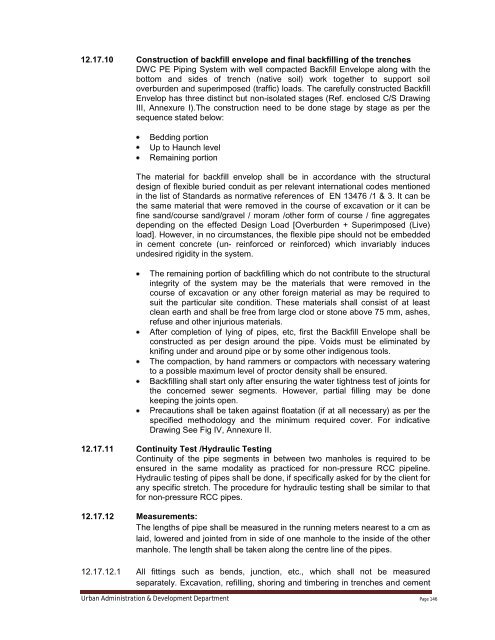Specifications Part 1 - Water Supply, Sewerage and Tube Well Works
Specifications Part 1 - Water Supply, Sewerage and Tube Well Works
Specifications Part 1 - Water Supply, Sewerage and Tube Well Works
You also want an ePaper? Increase the reach of your titles
YUMPU automatically turns print PDFs into web optimized ePapers that Google loves.
12.17.10 Construction of backfill envelope <strong>and</strong> final backfilling of the trenchesDWC PE Piping System with well compacted Backfill Envelope along with thebottom <strong>and</strong> sides of trench (native soil) work together to support soiloverburden <strong>and</strong> superimposed (traffic) loads. The carefully constructed BackfillEnvelop has three distinct but non-isolated stages (Ref. enclosed C/S DrawingIII, Annexure I).The construction need to be done stage by stage as per thesequence stated below:Bedding portionUp to Haunch levelRemaining portionThe material for backfill envelop shall be in accordance with the structuraldesign of flexible buried conduit as per relevant international codes mentionedin the list of St<strong>and</strong>ards as normative references of EN 13476 /1 & 3. It can bethe same material that were removed in the course of excavation or it can befine s<strong>and</strong>/course s<strong>and</strong>/gravel / moram /other form of course / fine aggregatesdepending on the effected Design Load [Overburden + Superimposed (Live)load]. However, in no circumstances, the flexible pipe should not be embeddedin cement concrete (un- reinforced or reinforced) which invariably inducesundesired rigidity in the system.The remaining portion of backfilling which do not contribute to the structuralintegrity of the system may be the materials that were removed in thecourse of excavation or any other foreign material as may be required tosuit the particular site condition. These materials shall consist of at leastclean earth <strong>and</strong> shall be free from large clod or stone above 75 mm, ashes,refuse <strong>and</strong> other injurious materials.After completion of lying of pipes, etc, first the Backfill Envelope shall beconstructed as per design around the pipe. Voids must be eliminated byknifing under <strong>and</strong> around pipe or by some other indigenous tools.The compaction, by h<strong>and</strong> rammers or compactors with necessary wateringto a possible maximum level of proctor density shall be ensured.Backfilling shall start only after ensuring the water tightness test of joints forthe concerned sewer segments. However, partial filling may be donekeeping the joints open.Precautions shall be taken against floatation (if at all necessary) as per thespecified methodology <strong>and</strong> the minimum required cover. For indicativeDrawing See Fig IV, Annexure II.12.17.11 Continuity Test /Hydraulic TestingContinuity of the pipe segments in between two manholes is required to beensured in the same modality as practiced for non-pressure RCC pipeline.Hydraulic testing of pipes shall be done, if specifically asked for by the client forany specific stretch. The procedure for hydraulic testing shall be similar to thatfor non-pressure RCC pipes.12.17.12 Measurements:The lengths of pipe shall be measured in the running meters nearest to a cm aslaid, lowered <strong>and</strong> jointed from in side of one manhole to the inside of the othermanhole. The length shall be taken along the centre line of the pipes.12.17.12.1 All fittings such as bends, junction, etc., which shall not be measuredseparately. Excavation, refilling, shoring <strong>and</strong> timbering in trenches <strong>and</strong> cementUrban Administration & Development Department Page 146
















